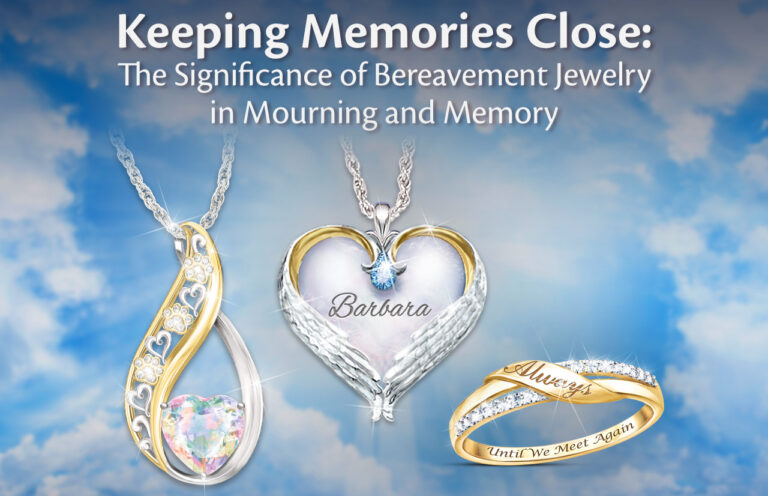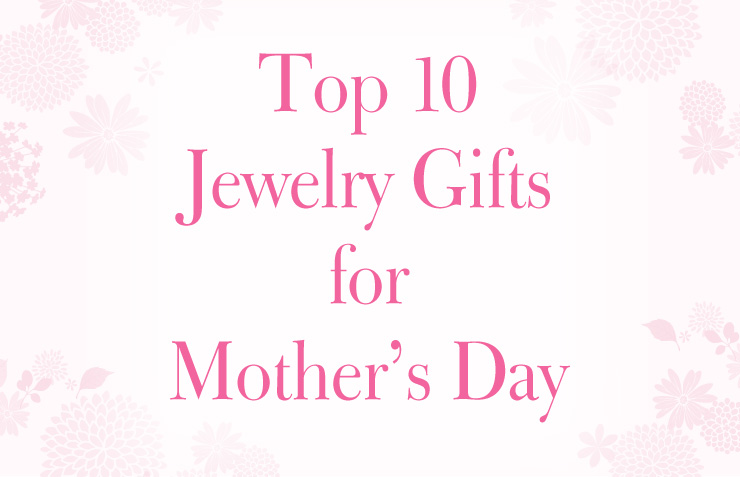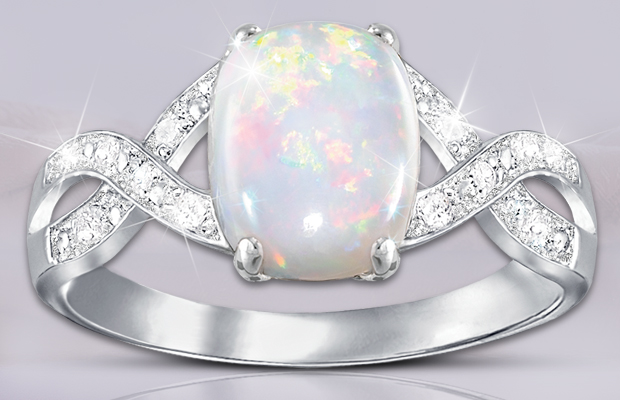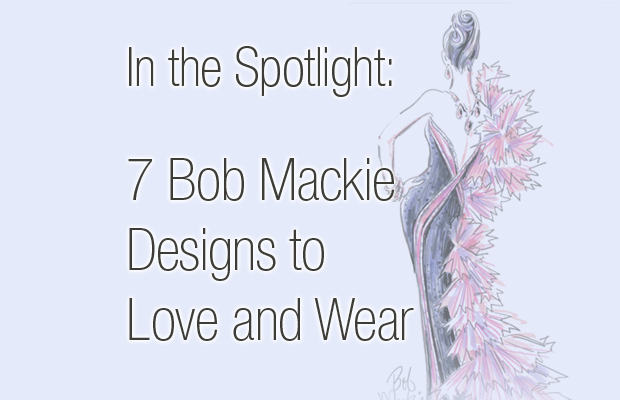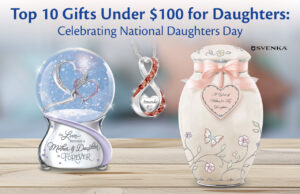Loss is a universal experience that touches us all at some point in our lives. In the wake of such profound sorrow, the human heart seeks solace in preserving the memories of those who are no longer with us. Bereavement or memorial jewelry, with its timeless significance and deeply personal nature, emerges as a cherished means to honor and carry forward the legacy of our departed loved ones.
As we delve into the history of memorial jewelry, we uncover not just a tradition of remembrance but a cultural narrative of evolving attitudes toward life, death, and the enduring bonds of love and friendship.
Table of Contents
Types of Bereavement Jewelry
The spectrum of bereavement jewelry is as diverse as the memories it encapsulates. Each piece offers a unique vessel for cherished keepsakes such as ashes, fingerprints, and heartfelt engravings, from delicate lockets to antique-style brooches to elegant rings and bracelets. Examples abound, from heart-shaped lockets to intricately designed pieces that speak volumes without uttering a word.
Common Symbolism for Memorial Jewelry
Embedded within the motifs of mourning jewelry lies a rich tapestry of symbolism. From the more macabre symbolism of the memento mori of the past, like skulls, bones, Ankhs, and white roses, to newer traditional images, like doves, cardinals, crosses, and forget-me-not flowers, all these reminders embody the enduring nature of love and memory. Eternity symbols adorn these pieces, reminding us that love transcends the bounds of time and space, resonating across generations.
The Historical Context of Mourning Jewelry
Throughout history and across cultures, mourning jewelry has played an important role in commemorating the departed. From ancient civilizations to today, these pieces have served as tangible tokens of remembrance and expressions of enduring love. From simple gold bands worn in the 17th century to the elaborate earrings and brooch sets of the Victorian era, mourning jewelry reflects evolving cultural attitudes toward death and grief. Each piece carries with it not just the weight of loss but also the profound connection shared between the wearer and the one who is no longer with them.
Early examples of mourning jewelry incorporated symbols such as skeletons, gravediggers’ tools, and winged death’s heads, rooted in the memento mori tradition – a reminder of the inevitability of death. These somber motifs adorned rings, brooches, and pendants, alongside other forms of memorialization like broadsides and portraits.
As the 18th century transitioned into the 19th, mourning jewelry evolved, softening its imagery to portray vignettes of loss and sorrow. Neoclassical motifs depicted women in mourning attire beside tombs, while hair work – a practice of weaving locks of hair into jewelry – became a prevalent form of remembrance. Painted portraits gave way to early photographic techniques, capturing the likeness of the departed in enduring memory. In some cases, the family would gather even after the death of the loved one to capture a final family portrait, posing with the departed loved one in a seated position before they were placed in their coffin for internment.
Items crafted specifically for mourning followed trends in jewelry design, with funeral rings and love tokens incorporating locks of hair exchanged between loved ones. The exchange of hair as a keepsake, as exemplified by Abigail Adams’s commissioning of a ring and brooch for Mercy Otis Warren, became a cherished tradition among friends and family.
In the mid-19th century, mourning jewelry reached its zenith of ornateness, influenced by Queen Victoria’s profound mourning for Prince Albert, the massive losses of the American Civil War, and the morbid themes of the Gothic revival. Elaborate gold bands and brooches, adorned with jet stones or pearls, became emblematic of mourning attire, while intricate hairwork designs adorned jewelry with intricate patterns and motifs.
Whitby Jet – And The Victorian Mourning Boomtown
Whitby Jet, a lightweight mineraloid prized for its deep black hue and brilliant polish, has long been cherished for its use in mourning jewelry. Formed from the fossilized wood of trees dating back over 135 million years, some of the finest jets in the world have been mined or washed ashore along the coast of Whitby in Yorkshire, although it can also be found in other regions globally. Historically, jets have been utilized for a myriad of purposes, from jewelry to miniature furniture and even building models.
In Victorian times, mourning ornaments crafted from Whitby jet were highly esteemed and considered appropriate attire for periods of deep mourning, like that observed by Queen Victoria. Initially carved by hand, the advent of lathe technology revolutionized jet carving, establishing a thriving industry in Whitby by the 1850s, with around 50 workshops dedicated to jet craftsmanship. The Great Exhibition of 1851 showcased samples of jet-working, further fueling its popularity. By 1873, the trade boasted fifteen hundred workers and two hundred miners extracting the raw mineral. Despite dwindling supplies and changing fashion trends, mourning jewelry made from Whitby jet remained in vogue well into the early twentieth century.
Mourning Rings
Mourning rings have a rich history, with roots dating back to antiquity and gaining in popularity by the 14th century. However, it wasn’t until the 17th century that they began distinguishing themselves from more general memento mori rings. By the mid-18th century, jewelers began to tout the swift production of these rings. Typically, they featured a single small stone, with details of the deceased depicted in enamel on the band. However, by the latter half of the 19th century, a shift occurred towards mass-produced rings adorned with a photograph of the departed mounted on the bezel. This marked the decline of traditional mourning rings by the end of the century.
The tradition of mourning rings, crafted from Bakelite, experienced a revival in the United States during the 1930s and 1940s. These rings featured a small picture of the deceased.
National Memorial Jewelry
The passing of two revered American figures, George Washington and Abraham Lincoln, sparked nationwide periods of mourning, prompting a surge in demand for commemorative items. Following Washington’s death in 1799, mourning souvenirs such as memorial paintings, china, handkerchiefs, needlework, medals, and jewelry became highly sought-after tokens of remembrance. Similarly, Lincoln’s assassination in 1865 led to an outpouring of grief across the nation, with relics taken from his bedside, including locks of his hair, becoming cherished mementos. As a symbol of his martyrdom for the cause of freedom, elegiac odes, engravings, medals, and jewelry were created in his honor. Notably, the Lincoln ferrotype pin, originally used during his re-election campaign in 1864, transitioned into a poignant mourning brooch following his tragic assassination. Similar items bearing his image were also worn after the assassination of President Kennedy in the 1960s.
The Significance of Bereavement Jewelry Today
In our modern era, bereavement jewelry takes on new meaning as a source of comfort and solace for those navigating the depths of grief. More than mere adornments, these pieces become intimate companions, offering a discreet yet powerful reminder of the enduring bond between the living and the departed. They serve as silent witnesses to our deepest emotions, providing a sense of closeness even without physical presence.
Modern take on this tradition includes wearing wedding rings long after one partner has passed, lockets, pendants, bracelets, and special remembrance rings containing loved ones’ hair or beloved pets’ fur. New technologies allow cremains to be crafted into gemstones and placed into jewelry. Symbolic designs incorporating traditional components like jet, bone, and memento mori messages are today crafted with the latest jewelry-making techniques. Many designs incorporate religious symbolism.
Types of Mourning Jewelry: The spectrum of bereavement and memorial jewelry is as diverse as the memories they encapsulate. From delicate lockets to elegant rings and bracelets, each piece offers a unique vessel for cherished keepsakes such as ashes, fingerprints, or heartfelt engravings. Examples abound, from heart-shaped lockets to intricately designed pieces that speak volumes without uttering a word.
Symbolism: Embedded within the motifs of mourning jewelry lies a rich tapestry of symbolism. Doves, symbols of peace and eternal love, intertwine with forget-me-not flowers, embodying the enduring nature of memory. Eternity symbols adorn these pieces, reminding us that love transcends the bounds of time and space, resonating across generations.
The Process of Choosing Bereavement Jewelry: Selecting the right piece of bereavement jewelry is a deeply personal journey, guided by practical considerations and emotional resonance. Whether opting for a piece that holds tangible remnants of a loved one or one adorned with poignant engravings or words of devotion, the process is honoring their memory while finding solace for oneself or often giving as a thoughtful bereavement gift.
Customization and Personalization Options: In memorial jewelry, customization is critical to creating a truly meaningful keepsake. Engraved names, significant dates, or personal messages infuse these pieces with a profound sense of individuality and connection. Birthstones, custom designs, and symbols specific to a lost loved one further personalize these treasures, ensuring they resonate deeply with the wearer’s heart.
The Therapeutic Benefits of Wearing Bereavement Jewelry: Psychologically and emotionally, bereavement jewelry offers a balm to the grieving soul. By keeping a physical token of a loved one close at hand, wearers find solace in the tangible presence of their memory. Expert opinions and studies underscore the therapeutic value of these cherished keepsakes, affirming their role in the healing process.
In the tapestry of grief, bereavement, and mourning, jewelry emerges as a valuable thread, weaving the past and present together in a timeless embrace. As we navigate the depths of loss, these cherished keepsakes serve as beacons of light, guiding us through the darkest of days. May we find comfort in the memories they hold and solace in the enduring love they represent?
The Bradford Exchange is a resource for those seeking mourning jewelry and other bereavement keepsakes to remind them of their loved ones. We offer a wide variety of designs and personalization options. You can see them on our website’s Memorial Jewelry and Bereavement Gifts sections.
Thank you for reading. We hope we’ve given you a little history of the tradition of memorial jewelry and its historical and modern use.
Keeping Memories Close: The Significance of Bereavement Jewelry in Mourning and Memory by The Bradford Exchange
